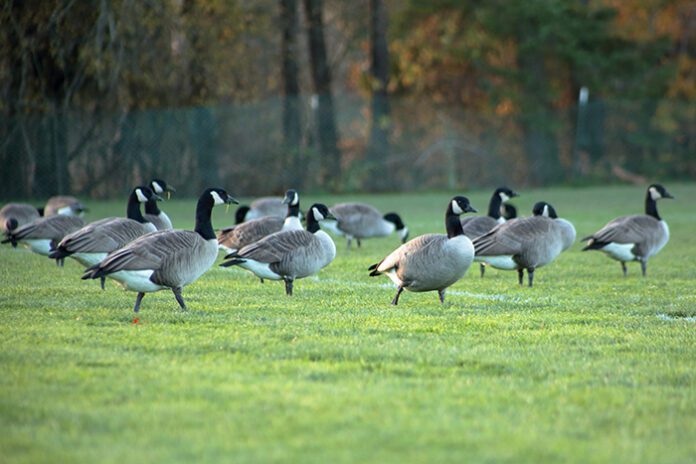Regional officials are recommending more funding to expand efforts to contain the area’s rapidly growing Canada goose population –– nearly one-third of which have taken up residence on fields and beaches in the Southern Gulf Islands.
Counts completed in the Capital Regional District (CRD)’s 2024 Regional Canada Goose Moult Survey indicated a population of approximately 6,669 resident geese, which is two to four times higher than estimated by previous surveys, and likely to be a considerable undercount, according to CRD senior environmental protection manager Glenn Harris.
Harris told the Environmental Services Committee Wednesday, Oct. 16 that current efforts were at best keeping pace with the birds’ growing numbers, and that a new survey indicated those on the Southern Gulf Islands represented 30 per cent of the total population in the capital region –– mostly at the north end of Salt Spring Island, but also on Pender and Mayne islands.
“The current resources in the service appear sufficient to maintain the population at its current levels,” said Harris. “But additional resources would be required to reduce the regional population to a level that meets economic, social and environmental objectives.”
Those economic objectives are in sharp focus for regional hay, grain and vegetable farmers whose livelihoods face “severe” impacts, according to Robin Tunnicliffe, who chairs the Peninsula and Area Agriculture Commission. Tunnicliffe told committee members more action from the CRD was needed to prevent crop losses.
“We’re asking for a major goose cull in 2025,” said Tunnicliffe, who said even the use of propane-air cannons hadn’t deterred the geese. “With Canada’s food safety standards, a lot of crops have to be abandoned –– and there’s no crop insurance that covers wildlife damage.”
According to the CRD, the only Canada geese historically found in the area around Vancouver Island were the occasional migratory visitors over the autumn and winter months. Numerous introduction programs were implemented by the Canadian Wildlife Service and BC Fish and Wildlife Branch in the 1960s and 1970s, meant to increase wildlife viewing and hunting opportunities.
But the introduced birds –– from numerous subspecies –– were unable to learn migrating behaviour patterns from their parents, interbreeding and eventually creating a hybrid population of non-migratory residents not native to the region.
“The exponential growth of the regional [Canada goose] population is degrading coastal ecosystems and waterways by over-grazing, trampling vegetation, soil erosion and the spread of invasive species,” according to a CRD report. “These areas include endangered Garry oak ecosystems, nearshore islands in ecological reserves and estuaries that are critical habitats for young salmon.”
CRD staff also pointed to public health concerns at recreational sites due to high densities of fecal matter, and the increased risk to poultry farms from Highly Pathogenic Avian Influenza spreading with geese as vectors.
“Flocks of over 500 birds are regularly landing in fields and ponds,” said Tunnicliffe. “The farmers stand to lose up to $1 million if avian flu were to strike at certain points in their growing cycle –– and vegetable farmers live in fear of E. coli contamination that’s introduced from Canada geese infestations.”
Harris said multiple First Nations representatives had expressed interest in participating in both the nest addling and harvest of birds. Future management efforts, according to CRD staff, should be expanded to include regions where no egg addling or First Nation harvests are known to occur –– including Salt Spring, which the recent survey found had a larger resident population of adult and juvenile Canada geese than Pender and Mayne islands combined.
“Perhaps the Gulf Islands are key areas of ‘hot spots’ for harvest potential,” said Harris. “We know there’s interest. What’s needed is resources to carry that out.”
The current service budget is currently $237,000, which last year supported the new survey, a part-time coordinator, an egg addling program that included hiring a six-week assistant goose management technician, and one harvest. The committee voted to recommend the CRD Board direct development of an increase in the service levels at its next meeting on Wednesday, Oct. 30.


Regarding the culling of Canada geese – would it be feasible to freeze the meat and use it to feed the needy? It seems that not to attempt this would be wasteful.